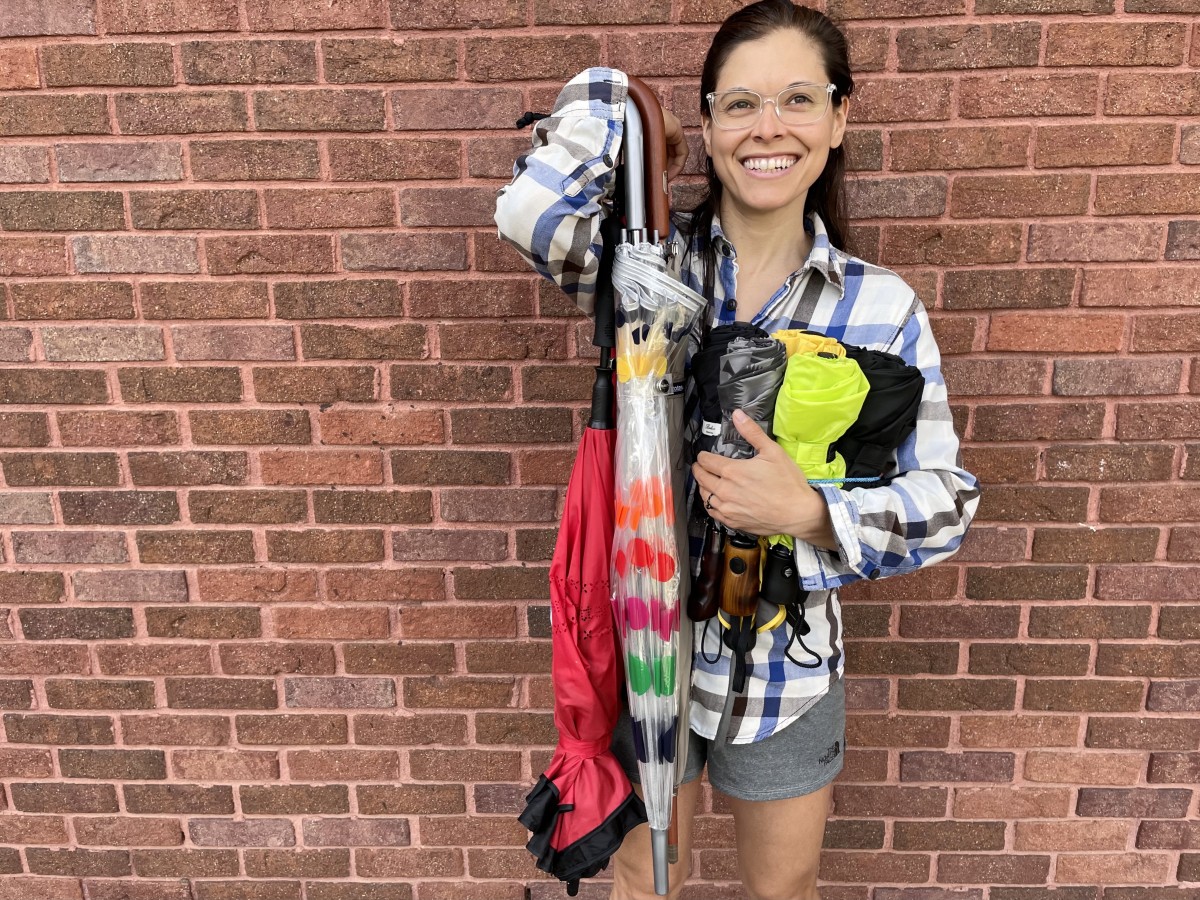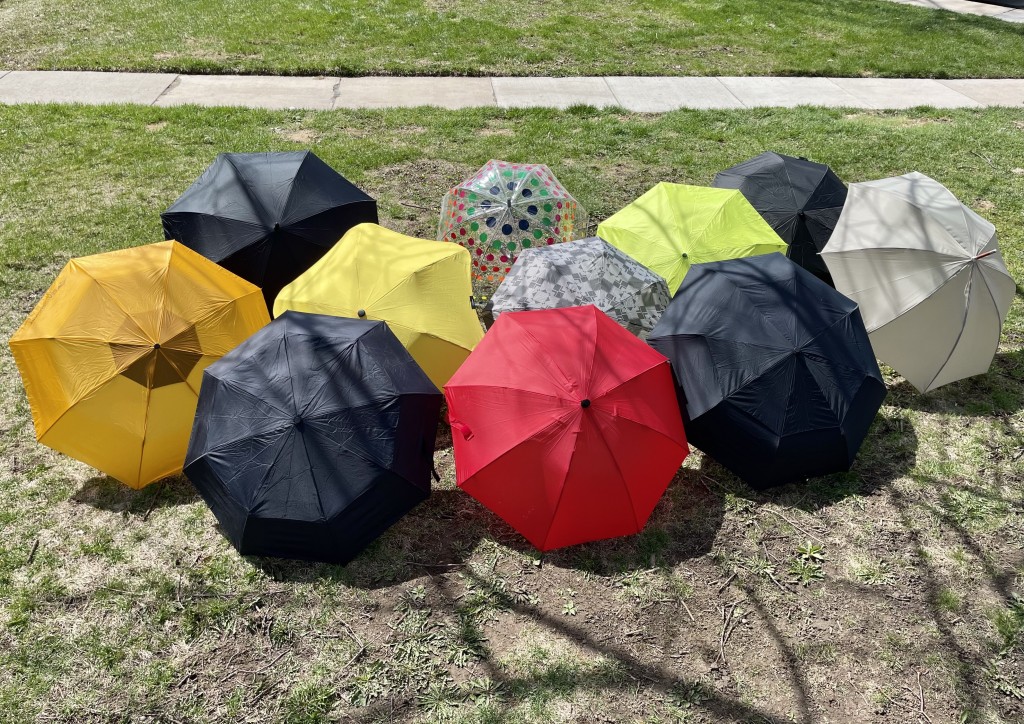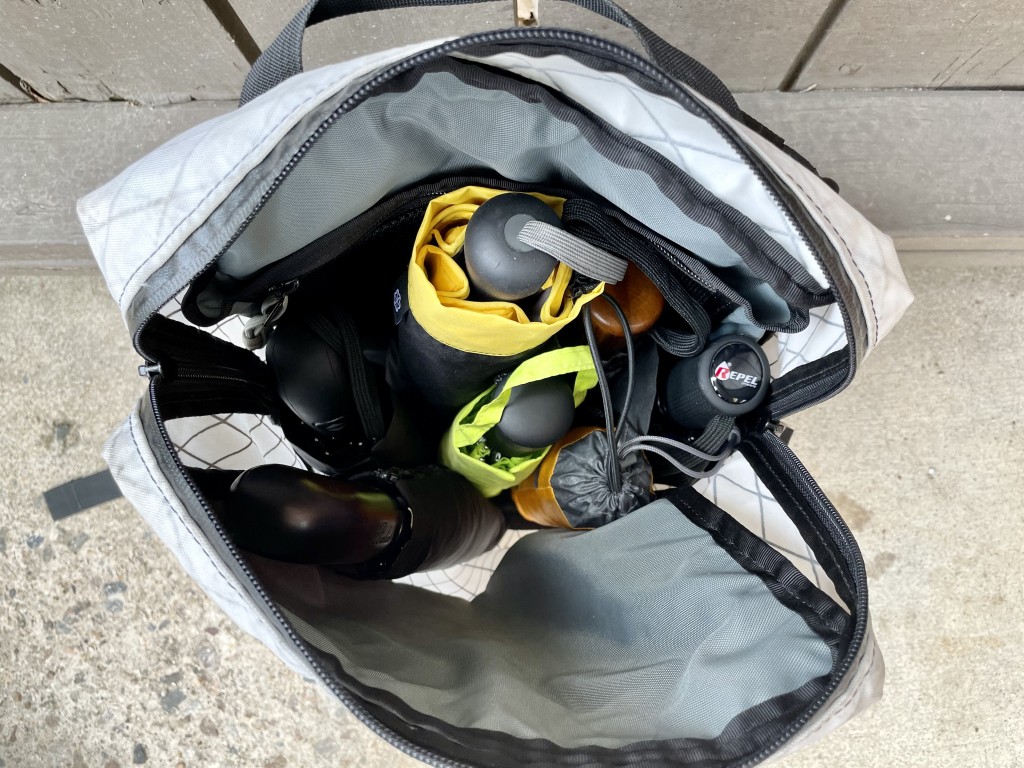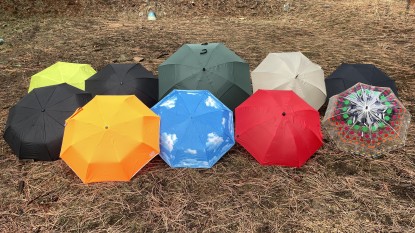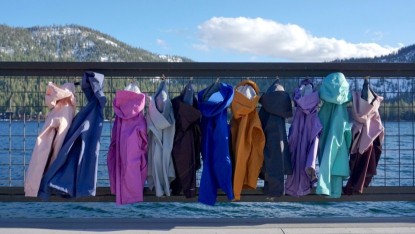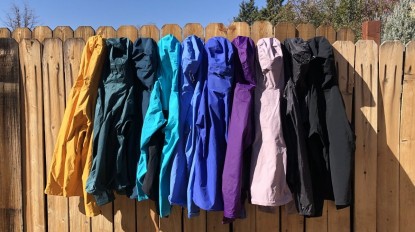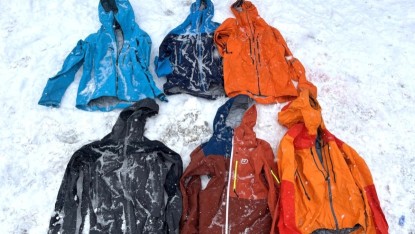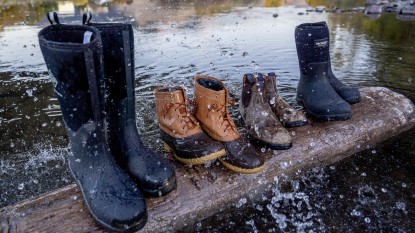Are you traveling to a rainy destination? Maybe you've just moved to a rainy climate? Or perhaps your trusty old 'brella finally snapped a stretcher, and you're in dire need of a replacement? We selected a broad range of sizes and styles to use everywhere, from the Pacific Northwest to the foothills of the Rocky Mountains, from urban centers and beyond. We tested traditional crook handle canopies, bright compact models, business-casual styles, and discrete travel-friendly versions.
We used several metrics to compare each product's nuances, learning a ton along the way. In general, there are two different types of umbrellas on the market: compact models (that telescope) and fixed-shaft models. Each has its own advantages and drawbacks. Compact models tend to be lightweight and smaller in size when fully compressed, whereas non-compact models tend to be heavier and aren't as easy to carry. This isn't always 100% true, however, so it's always best to compare the weight and dimensions of each product. Fixed-shaft models, though, are generally more sturdy, especially in the wind, and, as seen from our experiences, none of the fixed-shaft models flipped inside-out in the wind during our tests.
We've put together an outline of what you should consider when purchasing an umbrella. But first, we'd like to provide more information about the distinctions between the various designs and the benefits of each one.
Types of Rain Protection
Let's break down various types of rain protection. You often have the option between "traditional" (non-compact or fixed-shaft) umbrellas and compact ones, as previously mentioned. The former are classic in their form and generally quite sturdy, albeit cumbersome. The latter are small enough to carry with you at all times in your day bag yet tend to be less durable. In both categories, there are variations in weight, canopy size, and packed length (among an array of other technical specs). These factors all impact a model's ability to shield you from weather conditions, as well as the overall ease of use and portability.
Non-Compact
These models, also known as stick or fixed-shaft umbrellas, were once the only type available. To close them up, the canopy simply drops around the shaft, leaving you with a cane-like stick. In the traditional models we've tested, the shafts are a single piece of wood or metal, which we often find to be quite sturdy. Because these canopies do not compress down, the spokes of the frames don't have as many hinges. Thus, we found the simplicity of traditional models to often be of higher quality, more durable, and capable of withstanding high wind and repeated opening and closing. We also think these designs tend to win style points due to their more "refined" or classic look.
The downside of non-compact models is typically their size and weight. They won't usually fit very nicely on the floor of your car and definitely not inside a standard backpack. But, sometimes, you come across an umbrella that just has it all despite its fixed shaft, particularly with the use of incredibly lightweight but strong materials. Material technology never ceases to amaze us. Too, some of these larger umbrellas come with a storage sleeve that also has a sling attached for easier carrying.
Compact
Compact, or "travel" models, are designed to be convenient and easily accessible whenever a storm begins to brew. They combine telescoping shafts with folding canopies in order to be highly portable. Closed up, this type takes up significantly less space than the non-compact competitors. They also tend to be much more lightweight than many of the traditional models. A great choice for travel, they are usually the only option for storing in your purse, tote bag, or briefcase.
The factors that make compact models so easy to transport, however, also tend to make them less durable. There are a few reasons for this, mainly due to there being more moving parts, such as hinges in the stretchers. Repeated use and abuse may weaken all of these moving aspects. The extra hinges also increase the likelihood that the canopy will flip inside out during high wind. Furthermore, the lightweight shafts of the compact models we've tested thus far feel less sturdy overall due to the overlapping telescoping tubes, which create a potential for unwanted rotation, and, therefore, a less stable experience of holding and controlling the umbrella.
Rain Jackets
Wearing a rain jacket is another way to stay dry in the rain, but an overhead canopy offers a few things that a rain jacket can't, the first of which is a large amount of ventilation. This is both a blessing and a curse. A rain jacket technically protects better against the elements, as when the wind picks up and the rain starts to blow sideways, you're less likely to get wet with a jacket. On the other hand, the lack of ventilation and general breathability of the fabrics used means you're more likely to sweat inside (breathable waterproof fabric is still somewhat of a myth). No matter how breathable a jacket claims to be, if it's simultaneously warm and rainy out, you're going to feel like your jacket has become a personal sauna. Carrying an overhead canopy, however, allows air to circulate around you and will thus provide more comfort in the long term, as you have more versatility with your wardrobe or can wear a rain jacket but not have it zipped up.
Rain jackets do protect your upper body, but water will still shed down onto your pants. If a canopy is large enough, it can create a pocket completely devoid of rain, which will ideally shelter not just your torso but your lower body as well. That said, most real-world scenarios of rain include wind, and therefore unless you're wearing waterproof pants and boots, your legs are going to get wet no matter what. Even your torso will if it's very windy, so it really does depend on the typical climate patterns you experience in your region. If you plan to be walking outside during windy downpours, then a rain jacket is a must in addition to utilizing an umbrella. Rain jackets are also great options for hiking or backpacking, whereas umbrellas might not be. An overhead canopy definitely won't be able to keep you warm on cold and windy summits.
Weather Protection
Designed primarily to protect you from the rain, other conditions such as wind can alter how well an umbrella performs. Here we explain what factors you should consider for different weather conditions.
Rain
Protection from the rain is the first and foremost necessity. The first thing to consider is the size of the canopy: the larger the footprint of the canopy, the greater the likelihood of protection from overhead precipitation.
However, choosing the product that's right for you is a little more complicated than just going out and buying the one with the biggest canopy you can find. It's also important to consider the depth of the canopy, as a canopy with a deeper dome will allow you to hide more of yourself within it during greater rain and wind events. Keep in mind that the more compact the product is, the more likely the overall expanse of the canopy is going to suffer. However, it's a trade-off that may be in your best interest, especially if it means actually having your umbrella when it begins to rain. We feel that products with the best combination of compact size for carrying and coverage during rain are going to provide the best overall experience.
The models we've tested have had varying canopy diameters, ranging from 33.5 to 52 inches. However, the smaller diameters can be misleading without also taking into consideration the depth of the canopy. For example, the 33.5-inch diameter is from a product with a bell shape and a depth of 16.75 inches. Such gratuitous depth is what makes up for the relatively narrow diameter. But in general, smaller canopies without much depth will likely perform just fine when it's sprinkling. They are also great for kids. Additionally, if you plan to use yours for a hike in the woods or a crowded urban market, a smaller canopy diameter will be more maneuverable and less likely to get caught on bushes or other humans. If you need an umbrella to withstand downpours and high gusts, we recommend you steer clear of compact models altogether and go with a sturdier stick model.
Wind
Not surprisingly, the wind has a huge effect on how well a canopy can protect you from the rain. If you have a product that easily flips inside out, a stray gust can quickly leave you without protection. And if it caves in or becomes unmanageable in relatively low winds, then you're certainly in trouble. We have found that a rounder shape tends to be more wind-resistant and that having a double canopy (AKA, wind vent) design helps purge some of the pressure of the wind.
Some models might have fairly deep canopies where you can pull them down over your head and shoulders for extra protection from the wind. A tip for lots of rain and wind is to take shorter steps, which will help keep your legs and feet beneath the canopy. It seems counter-intuitive to walk slowly in the rain, but trust us — it helps. During our testing, we learned that the best defense is to tilt the canopy toward the oncoming wind and rain. Deeper canopies certainly allow you to hide more of your head and upper torso inside.
A drawback with depth, however, is visibility. Which is where fun, bubble-style models come in. They are excellent against strong gusts thanks to their narrow diameter and iconic depth but have a clear plastic canopy for visibility. In general, the wind is quite an unpredictable force, and in our experience, umbrellas do not perform as well as manufacturers often claim online, so always be prepared for a struggle in high wind, no matter the quality of the product.
Sun
Not only will an overhead canopy keep you dry in the rain, but it can also give you some shade from the sun. A predecessor to the umbrella — the parasol — was invented to block rays on hot days. The larger the canopy, the more shade you are going to get, but if you plan on using it while on a hike, a smaller, lightweight, and more compact model will likely benefit you better than a non-compact model. On the other hand, if you are planning to spend the day at the beach, you won't necessarily be concerned about how easy it is to transport or use while walking, so a model with the largest canopy you can find may be just what you need. Another thing to consider is the color of the canopy. A dark color or pattern will absorb more light and radiate more heat underneath. And, of course, clear or brightly colored canopies won't provide much shade, if at all.
Ease of Transport
Once you've thought about the weather conditions where you live, you should consider how easily the different models are to transport, especially if you travel frequently or use public transportation on a daily basis. If you are always on the move, you likely won't want to purchase a product that will be too bulky to carry with you. Within this category, there are two major factors to consider: size when collapsed and weight.
Size
If you live in a city and rely on public transportation or have to walk long distances, a compact model is likely your best option. You can carry it on your person without it being cumbersome but still have the security of knowing that if a rainstorm pops up, you'll be ready. Among the products we selected for this review, the collapsed sizes and designs varied greatly. Many of the models came with their own sleeves to help slim down and pack the umbrella away neatly. But even then, some of the models were a little wider and bulkier. If you aren't going to choose a compact model, considering handle design and weight could offset any inconveniences with length. Handles with leashes or lanyards are definitely helpful, and even a curved handle, like many classics, provides an easy grip.
It's also best to consider where you will be storing your umbrella or what your means for carrying it around would be, whether it is via a bag, backpack, or the floor of your car. Will the length and bulk of the umbrella suit your needs, or work with whatever bag or car you have available? And if you prefer stick styles, then consider any must-haves, like a sleeve with a sling or a curved handle to hang on rails or on the backs of chairs.
Weight
Suppose you live in a very wet climate and want to be able to carry that just-in-case umbrella in your purse, backpack, or briefcase on a daily basis. In that case, we recommend looking at the smallest and lightest models on the market, which range roughly from 10 to 14 ounces. By contrast, if you simply need an overhead canopy to get you from your car to work or to casually walk your dog, you probably want to opt for a larger, non-compact model, which is typically closer to or over one pound. There are exceptions to this, but they aren't very common. A pound might not sound like very much, but after extended use, we have found that a pound can wear down your arms faster than you think.
Other Transport Considerations
It's also important to think about how a sleeve can make deploying the canopy a little slower. If a sudden shower appears, you don't want to be caught fumbling with a too-tight sleeve. Some models have sleeves with zippers for this reason. On the other hand, the small case offers the definite perk of having something to contain the wet canopy when packed, not to mention that the sleeve will also cover up the ends of the spokes so as not to catch on anything while stored. Compact models traditionally have a storage sleeve, while non-compact models typically do not. However, we have seen a couple of traditional models with slings sewn onto them, which aid in carrying them. We prefer sleeves with wide openings for quick and easy stowing, as well as accessories like leashes or carabiners (or even a crook handle) to make them easy to attach to a bag or to hang.
Construction Quality
The strength of a canopy's support (i.e., its shaft and stretchers) plays a big part in how well it will perform and whether or not it is likely to fail during use. Beginning this review, we were tempted to think that the heavier the product, the more durable it would be and that lightweight products couldn't handle the same abuse. We soon learned that this is not always the case. Here, we break down how different materials and construction can affect overall durability, quality, and wind resistance.
Shafts & Stretchers
Some of the products in this review have fiberglass or wooden elements, while others are made of metals such as steel and aluminum. Of all the models we tested, we believe the strongest shafts are those that do not telescope down into a compact size. When a shaft is made of a single piece of material, any abuse will be distributed throughout the entire piece. In contrast, a shaft made of various sections will have more points of failure, where it can undergo torque and possibly break or deform.
Not too surprisingly, we've discovered that the stretchers are more likely to fail long before the shaft. If you've ever owned a lightweight model, you've probably seen bent or broken stretchers. These lighter-weight products are more likely to flip inside-out during windy events as the stretchers' numerous hinges can bend backward. Over time, we expect repeated canopy inversion and correction will stress, and eventually damage, the stretchers.
Another thing to consider is the type of material constituting the stretchers and hinges. Steel or iron, while stronger, are more likely to rust, which means it's important to make sure all the pieces are completely dry before you collapse and store the canopy. Fiberglass doesn't rust, which means you can get away with storing it while it's still wet. Fiberglass is also more flexible and therefore won't snap as easily when bent. Aluminum can oxidize over time but doesn't degrade or rust in the same way.
Canopy
Canopies come in a wide range of sizes and are made of a variety of materials. Most often, they are made of polyester or a similar tightly woven fabric. Other times you may find canopies made out of a type of plastic, like the thermoplastic polyurethane of a classic bubble canopy. Plastic is, of course, a waterproof material, while nylon or polyester canopies may have an added chemical coating. Often this specific information is difficult to find on the product's tags or even on manufacturer's websites. Regardless, it's more likely that you'll break the skeletal structure — or lose your umbrella entirely — before you have to worry about reapplying any waterproof finish or ripping a hole through the canopy.
Conventional canopies are designed so that the ends of the ribs have an eyelet, like the eye of a sewing needle. The canopy is then attached by stitching fabric through the eyelet and to the canopy. However, some companies have gotten creative and made pockets on the underside of the canopy for the ends of the ribs to reside. The obvious benefit of having the rib ends inside such pockets is pretty simple: no one's eyes will get poked out (hopefully), and pressure is better distributed to avoid wear of the sewing or fabric. Some models may have flat, blunt tips to prevent users from being stabbed or uncomfortably poked. These are small details, but details nonetheless.
The most typical canopy shape is an octagon, but we've tested hexagons and nonagons, too. We've noticed that despite how many panels it has, a canopy with a greater depth, such as around 8 inches or more, tends to do slightly better in the wind, but this could also depend on the quality of its material and underlying structure.
Final Considerations
We strongly recommend making your purchase decision based on the three major topics covered above: rain protection, ease of transport, and construction quality. However, if you're looking for the icing on the cake, this is where our final considerations come into play: ease of use and versatility. These days, most models open at the push of a button, which releases a mechanism or spring, and the canopy shoots open. However, some still require you to slide a runner up the shaft to fully deploy the canopy. Either method works, but the auto open (or better yet: auto open/close) feature is extremely convenient, especially if you only have one hand free.
The shape, size, and construction of the handle are also significant for ease of use. An ergonomic handle will make all the difference in a storm. If the handle is poorly shaped, it's going to make controlling the canopy more difficult, awkward, and uncomfortable. Some products have ergonomically designed handles and soft foam materials to add comfort while you're white-knuckled and racing to your destination. And if you have large hands, a larger handle is also going to be advantageous. Some handles are very small knobs with no ergonomic design to them at all, which we found uncomfortable and slippery.
Finally, when accounting for style and versatility, the most important thing to consider is what you'll be using your umbrella for. If you need to maintain a very business-like appearance, then a classic canopy is your best option: something black or blue with an octagonal shape would suffice. However, if you really want something that adds a "pop" to your outfit or to your life, look for unique canopy designs, colors, or patterns, which this industry has no shortage of.

